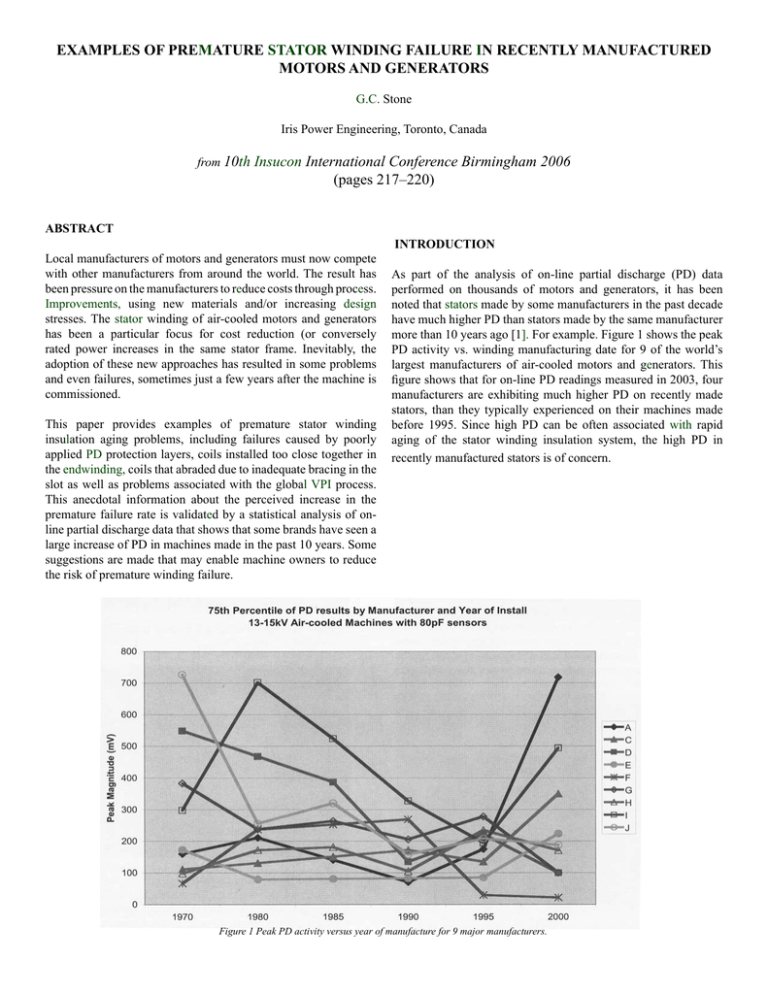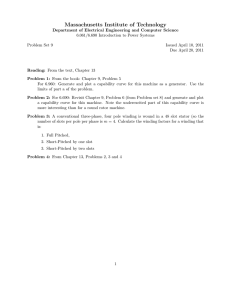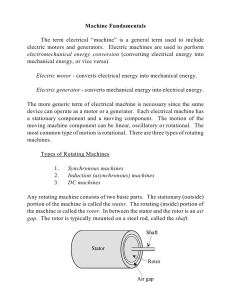EXAMPLES OF PREMATURE STATOR WINDING FAILURE IN
advertisement

EXAMPLES OF PREMATURE STATOR WINDING FAILURE IN RECENTLY MANUFACTURED MOTORS AND GENERATORS G.C. Stone Iris Power Engineering, Toronto, Canada from 10th Insucon International Conference Birmingham 2006 (pages 217–220) ABSTRACT INTRODUCTION Local manufacturers of motors and generators must now compete with other manufacturers from around the world. The result has been pressure on the manufacturers to reduce costs through process. Improvements, using new materials and/or increasing design stresses. The stator winding of air-cooled motors and generators has been a particular focus for cost reduction (or conversely rated power increases in the same stator frame. Inevitably, the adoption of these new approaches has resulted in some problems and even failures, sometimes just a few years after the machine is commissioned. This paper provides examples of premature stator winding insulation aging problems, including failures caused by poorly applied PD protection layers, coils installed too close together in the endwinding, coils that abraded due to inadequate bracing in the slot as well as problems associated with the global VPI process. This anecdotal information about the perceived increase in the premature failure rate is validated by a statistical analysis of online partial discharge data that shows that some brands have seen a large increase of PD in machines made in the past 10 years. Some suggestions are made that may enable machine owners to reduce the risk of premature winding failure. As part of the analysis of on-line partial discharge (PD) data performed on thousands of motors and generators, it has been noted that stators made by some manufacturers in the past decade have much higher PD than stators made by the same manufacturer more than 10 years ago [1]. For example. Figure 1 shows the peak PD activity vs. winding manufacturing date for 9 of the world’s largest manufacturers of air-cooled motors and generators. This figure shows that for on-line PD readings measured in 2003, four manufacturers are exhibiting much higher PD on recently made stators, than they typically experienced on their machines made before 1995. Since high PD can be often associated with rapid aging of the stator winding insulation system, the high PD in recently manufactured stators is of concern. Figure 1 Peak PD activity versus year of manufacture for 9 major manufacturers. Maughan has recently published a catalog of premature winding problems he has seen [2]. This paper presents additional examples of advanced insulation ageing that this author has recently seen in air-cooled motor and generator stators. Many of these deterioration processes resulted in premature winding failure. This paper also postulates reasons why some recently made stator winding insulation systems have higher PD activity, and some steps the user may take to reduce the risk of premature stator winding failure. ENDWINDING PD Coils operating at high voltage and placed adjacent toother high voltage coils in another phase require aminimum separation to avoid PD in the air space between coils. This PD will gradually erode the groundwall insulation and may lead to phase-to-phase stator failure. The higher the voltage class of the machine and the thinner the groundwall insulation, the greater must be the spacing [3]. ELECTRIC STRESS CONTROL COATING PROBLEMS Most stator windings rated >6 kV employ a carbon-loaded paint or tape on the surface of the coils or bars in the slot [3]. This ‘semicon’ coating prevents PD between the surface of the coil and the stator core in any small air gap that inevitably exits at this interface. In addition, most manufacturers use a silicon carbide-loaded paint or tape on the coil for 10 cm or so outside of the slot. This silicon carbide coating overlaps the semicon coating, and reduces the high electric field that would otherwise exist at the end of the semicon coatings. In the 1970s, there were a number of machines that exhibited very high PD and high ozone concentrations from either or both coatings that were caused by manufacturing problems. The problems seemed to originate from coatings where the carbon and/or silicon carbide was non-uniformly dispersed in the insulation matrix or where the application method resulted in microvoids just under the coating. In both cases the result was PD. This high PD created ozone that chemically attacked the insulation (not to mention heat exchanger metal and rubber components) and properly made areas of the coatings, resulting in the spread of the problem. This problem seems to be worse if the winding insulation operates at higher electric stress and/or higher temperature. Perhaps it is for this reason that there seems to be a recurrence of this problem in the past few years. Unfortunately, in many motors and generators we have noted inadequate spacing, and consequently high PD (and ozone). Figure 4 shows the white residue caused by ozone resulting from PD between two coils in different phases that were installed too close to one-another. Figure 3 Destruction of the coil semicon coating in the stator slot due to PD and ozone. Figure 4 PD occurring between high voltage coils in two different phases, where the spacing is insufficient to prevent the PD. Note that the spacing between adjacent coils is irregular, as a result of poor manufacturing processes. Figure 2 Semicon and grading coating overlap deterioration due to poorly applied or inadequate coatings. Figure 2 shows a hydrogenerator stator where a very noticeable white band is visible at the junction of the semicon coating and the silicon carbide coating. Figure 3 shows a winding where the semicon has virtually disappeared in the slot due to poor application of the semicon coating. Figure 5 shows a stator where the close spacing has resulted in highly stressed air adjacent to where two phase end coils (in different phases) make connection to the circuit ring bus. The resulting partial discharge eventually bores a hole through the insulation, triggering a phase-to-phase or a phase-to-ground fault. Figure 6 Photo of a coil removed from a hydrogenerator stator that failed due to slot discharge. The vertical stripes are where the insulation is not abraded, since the stator cire ventilation ducts are at these locations. Figure 5 Partial discharges occurring in the inadequate space (here filled with an insulating board) between two phases where the high voltage bars are connected to the circuit ring busses. (Courtesy C. Maughan) LOOSE COILS IN THE SLOT Coil vibration in the slot has long been a problem in all non-global VPI stators made with thermoset insulation systems such as epoxy mica. The first instances were reported over 50 years ago [3]. The root cause of the problem is that at full load, the twice power frequency magnetic forces will vibrate the coils if the coils are not tightly held in the slot. Consequently, the groundwall insulation rubs against the laminated steel core – a very abrasive surface. First the semiconductive layer of the bar or coil is abraded away, and then the groundwall insulation. The mechanism is sometimes referred to as slot discharge, because once the semiconductive coaling is abraded, partial discharges occur between the coil surface and the core, further increasing the rate of deterioration. Figure 7 Bar abrasion due to loose windings in the slot of a turbo generator that did not have sufficient sidepacking or a radial followup wedging system. Figure 6 shows a coil that was removed from the slot of a hydrogenerator where the semicon and about 30% of the groundwall thickness has been abraded away. The manufacturer had not mechanically secured the coils in the slots by means such as sidepacking, ripple springs, two part wedges, conformable restraint in the slots, etc. Figure 7 shows a bar in the process of being removed from the stator slot thai shows significant abrasion of the insulation in the slot, for the same reasons. Normally one would not expect loose coils to be a problem in a global VPI stator, since the coils are effectively glued to the stator core. However, if the coils are made too small for the slot, and are subjected to load cycling that creates shear stresses between the coils and the stator core, then loose coils and slot discharge may occur in some designs (Figure 8). Figure 8 Example of loose winding failure MVA global VPI generator stator. AVOIDING PREMATURE STATOR FAILURE The premature failures described above were a consequence of the design and/or manufacture of the stator. Specifically: • The electric stress control problems may be caused by poorly applied coatings. The deterioration process is accelerated in winding designs that cause a class F insulation system to operate above about 120°C and/or with an average groundwall electric stress above 3 kV/mm. • The endwinding PD is probably caused either by: (a) poor dimensional control of the coil and/or inconsistent alignment of adjacent coils in the slots; (b) too short an endwinding which does not allow enough circumference at the coil ends for sufficient air spacing between the connections; and/or (c) inattention to the air space and creepage distances needed when blocking and bracing are installed. • The loose coil in the slot problems may be due to a slot content design that does not take into account the gradual shrinkage of insulating and wedging materials, or where the need for tight coils has been sacrificed to make the coils easy to install in the slot. Probably the best way to avoid premature stator winding insulation problems is to have an adequate purchase technical specification. Some suggestions for terms to include in such a purchase specification, in addition to the relevant parts of 1EC 60034, are: • For a 30-year life, require a Class F insulation system to be operated at a Class B temperature rise. • Require that the groundwall insulation system pass a voltage endurance type test similar to those specified in IEEE Standards 1043 and IEEE 1553 (regrettably there is no 1EC equivalent specification that is well defined and has a pass-fail criteria). Requiring a voltage endurance test is probably better than specifying the maximum design electric stress, since this may retard the introduction of new materials and processes. For further assurance, require spare coils from the production batch for a stator to be subjected to a voltage endurance test. • Require a partial discharge test on the new winding, together with a ‘black-out’ test to ensure the coils are properly impregnated, and clearances in the endwinding are sufficient [4,5]. • For multi-tum coils, require a voltage surge test both on coils (for non global VPI stators) and complete windings, according to IEEE 522 (1EC 60034 Part 15 is not as effective in detecting weak turn insulation). • For non-global VPI stators, require the use of a wedging or sidepacking system that contains a follow-up restraint that ensures tightness as the slot contents shrink. This could include the use of two or three part wedges, ripple springs and/ or conformable materials such as silicon rubbc’i Alternatively consider requiring a clearance between the side of the coil and the core to be no more than 0.1 mm or so. • Insist on the right to make unannounced laciory inspections during manufacture of the stator. Note that most of the above terms may increase tin-cost of the stator winding, but will probably result in a longer winding life and less maintenance over the lifetime. The machine owner also has a responsibility to operate the machine within specification, keep the windings clean and tight, and preferably visually inspect the winding before the end of the warranly period. It would also be beneficial if manufacturers could educate users on the trade-offs of cost vs. life they make when designing a new winding. CONCLUSIONS 1. Problems such as coil abrasion in the slot, electric stress relief coating deterioration and partial discharges in the endwinding have lead to failures in as short as 5 years of operation. This anecdotal information is supported by the fact that PD fbi-some manufacturers is higher for recently made machines than for similar machines made over 10 years ago. 2. To avoid premature failures, users of modem air-cooled machines should ensure they have a good purchase specification and ensure the manufacturer has an appropriate QA program in place. REFERENCES 1. G.C. Stone, V. Warren, “Effect of Manufacturing Winding Age and Insulation Type on Stator Winding PD Levels”, IEEE Electrical Insulation Magazine. Sept 2004, pl3. 2. C.V. Maughan, “Root Cause Diagnostics of Generator Service Failures”, Proc IEEE International Symposium on Electrical Insulation, Sept 2004,pi 54. 3. G.C. Stone et al, “Electrical Insulation for Rotating Machines”, Wiley-IEEE Press, 2004 4. G.C. Stone, “A Suggested Approach for Specifying PD Testing as a New Winding Acceptance Test”, Proc. IEEE Electrical Insulation Conference, Oct 2005, pl59 5. Draft 1EC Standard 1EC 60034 Part 27, “Rotating Electrical Machines - Part 27 PD Measurements on the Stator Winding Insulation of Rotating Machinery”, Oct 2005.


